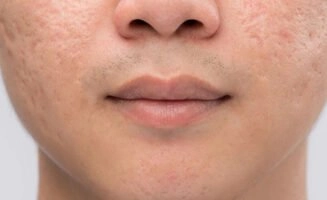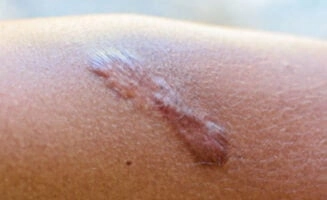
Scar Revision
Scars can serve as reminders of injuries, surgeries, or other events, but for many, they are an unwelcome mark on their appearance. At 740 Park Plastic Surgery in New York City, board-certified plastic surgeon Dr. Stafford Broumand offers expert scar revision treatments to help minimize the visibility of scars, allowing patients to feel more confident in their skin. Whether caused by trauma, surgery, or skin conditions, scars can often be significantly improved through both surgical and non-surgical techniques. Our goal is to help your scar blend more naturally with the surrounding skin, improving both its appearance and your quality of life. Conveniently located in Manhattan, we are proud to offer advanced scar revision treatments tailored to your unique needs.
What is a Scar?
A scar is the body’s natural response to healing damaged skin, forming as part of the wound recovery process. Composed primarily of fibrous tissue, scars can develop after surgery, injuries, infections, or inflammation. Scars can vary in appearance depending on several factors, such as the location of the wound, the type of injury, and an individual’s skin type. They may be raised, flat, indented, or have a different color or texture compared to the surrounding skin. While some scars may fade with time, others remain more noticeable, potentially causing discomfort, itching, or aesthetic
Trusted Source
Scars
Cleveland Clinic
Go to Source
concerns.
 Acne Scars
Acne Scars
 Surgical Scars
Surgical Scars
 Keloid Scars
Keloid Scars
Types of Scars
Scars come in a variety of forms, each influenced by the nature of the injury and how the body heals. Understanding the type of scar is essential in determining the most effective treatment plan. The main types of scars include:
Discoloration and Surface Irregularities
These scars are often cosmetic in nature, affecting the skin’s surface without causing discomfort or impairing function. Common examples include acne scars and minor scars from previous surgeries or injuries. While they may not cause physical issues, these scars can still impact appearance and be improved through non-surgical treatments or minor surgical procedures.
Hypertrophic Scars
Hypertrophic scars develop as thick clusters of tissue directly over the site of a wound. They are typically raised, red, and may cause discomfort. Over time, they can grow wider, and the coloration may range from hyperpigmented (darker) to hypopigmented (lighter).
Keloid Scars
Keloids are larger and more pronounced than hypertrophic scars, often extending beyond the original injury. They may be itchy or painful and are more likely to form on areas of the body with minimal fatty tissue, such as the neck, ears, chest, or shoulders. Keloids tend to be more challenging to treat due to their size and tendency to grow beyond the wound’s edges.
Contracture Scars
Contracture scars occur when large amounts of skin are lost, often after burns. These scars cause the surrounding tissue to tighten, which can limit movement, especially when they form around joints like the elbows, knees, or neck. In more severe cases, contractures may require surgical treatment to restore
Trusted Source
Scars: Signs and Symptoms
American Academy of Dermatology Association
Go to Source
mobility.
Identifying your type of scar is a key step in determining the most appropriate revision technique.


What is Scar Revision?
Scar revision is a treatment designed to improve the appearance of scars, helping them blend more seamlessly with the surrounding skin in terms of color, texture, and overall visibility. While scars cannot be entirely erased, scar revision can significantly minimize their prominence. Treatment options range from topical therapies, such as creams and gels, to more advanced techniques like laser treatments or surgery, depending on the severity and type of scar. Although scar revision is often performed for cosmetic reasons, some scars may require medical intervention if they cause discomfort, restrict movement, or impact daily function.
Who Gets Scar Revision?
Scar revision is an option for anyone who wishes to minimize the appearance of an unwanted scar. Scars can develop from various causes, and people may seek treatment to improve their appearance for both cosmetic and functional reasons. Common causes of scarring that often lead individuals to consider scar revision include:
- Acne scarring
- Burns, whether from accidents or radiation therapy
- Scars from a Cesarean birth (C-section)
- Scars left after cleft lip repair surgery
- Cosmetic or reconstructive surgery
- Piercings that leave noticeable scars
- Skin infections that result in scarring
- Traumatic injuries
Scar revision can help reduce the visibility of scars from these and other causes, making them less noticeable and restoring confidence in your appearance.
Who is a Candidate for Scar Revision?
Scar revision can be a suitable option for individuals of various ages who are looking to reduce the appearance of scars on their body. Ideal candidates for this procedure typically meet the following criteria:
- You are bothered by the appearance of a scar, whether from surgery, injury, or another cause.
- You are in overall good physical health.
- You do not smoke, as smoking can interfere with the healing process.
- You have a positive outlook and realistic expectations for the results of scar revision.
- You do not have active acne or other skin conditions in the area being treated, as these can affect the outcome.

Preparing for Your Scar Revision Treatment
Before your scar revision procedure, it’s important to follow a few key steps to ensure optimal results. Dr. Broumand may advise you to stop smoking and avoid certain medications, such as aspirin or anti-inflammatories, which can increase bleeding. Be sure to keep the treatment area clean and protect it from excessive sun exposure leading up to your procedure. If you’re undergoing surgical revision, arrange for someone to drive you home afterward, as you may need time to recover. Dr. Broumand and our team will provide personalized instructions based on the type of scar revision you’re receiving.

Surgical Scar Revision
Surgical scar revision involves the removal of an existing scar followed by the careful reconstruction of the wound. By re-approximating the tissue or using techniques like flap reconstruction or skin manipulation, Dr. Broumand aims to minimize the scar’s appearance and, in some cases, improve function. This procedure can be used to treat a variety of scars, including keloid scars, hypertrophic scars, acne scars, burn scars, and scars caused by injury or surgery.
In cases where the scar is large or restricts movement, surgical techniques like Z-plasty or W-plasty may be employed. These methods reshape the scar in a way that allows the surrounding skin to move more freely. For severe scars, such as those caused by burns, skin grafts may be necessary. Skin from another area of the body is used to close the wound when there is insufficient healthy skin at the treatment site.
Although surgical scar revision can significantly reduce the appearance of scars, it’s important to note that the results may not be permanent, especially with keloids. To help prevent the scar from returning, additional treatments, such as corticosteroid injections, may be recommended following surgery.
Scar Revision Surgery Recovery & Results
After surgical scar revision, the initial healing phase typically lasts one to two weeks. During this time, you may experience localized swelling, redness, and mild discomfort in the treated area. As healing progresses, the new scar will gradually refine and fade over the following months. Additional treatments, such as dermabrasion, chemical peels, or laser resurfacing, may cause similar side effects and increased sensitivity in the treated area.
Although the results of scar revision surgery can be long-lasting, it’s important to be patient during the recovery process. It may take several months to see the final outcome, and in some cases, it can take up to a year for the scar to fully mature and blend with the surrounding skin.
As with any surgical procedure, results may vary. While significant improvements are often achieved, there are no guarantees, and it may take more than one treatment to reach the desired
Trusted Source
What should I expect during my scar revision recovery?
American Society of Plastic Surgeons
Go to Source
outcome.
Non-Surgical Scar Treatments
In addition to surgical options, there are several non-surgical treatments available to improve the appearance of scars. These treatments are less invasive and can be effective for a variety of scar types, often used on their own or in combination with other procedures:
Laser Resurfacing
Laser resurfacing uses focused light to remove the outer layers of damaged skin, encouraging new skin growth and smoothing the appearance of scars. This treatment is especially effective for shallow scars and can also improve skin texture and discoloration.
Steroid Injections
Steroid injections are commonly used to reduce the size and thickness of hypertrophic and keloid scars. By injecting corticosteroids directly into the scar tissue, inflammation is reduced, and the scar’s appearance is softened over time.
Dermal Fillers
Dermal fillers can help improve the appearance of depressed or sunken scars, such as those caused by acne or injury. By injecting a gel-like substance under the skin, the scar is lifted, making it less noticeable and more in line with the surrounding skin.
Microneedling
Morpheus8 microneedling involves creating tiny punctures in the skin to stimulate the body’s natural healing process. This encourages the production of collagen and elastin, which can help to improve the appearance of scars by smoothing the skin and reducing their prominence.
Silicone Therapy
Silicone sheets or gels are often used to flatten and soften scars, particularly hypertrophic scars and keloids. Applied directly to the scar, silicone helps to reduce redness, prevent excessive scar tissue formation, and improve the overall appearance of the scar over time.
These non-surgical treatments provide a range of options for those looking to minimize scars without undergoing surgery, offering flexibility in creating a tailored approach for each individual’s unique needs.
FAQs About Scar Revision
How soon after an injury or surgery can I consider scar revision?
It’s generally recommended to wait until a scar has fully matured before considering revision treatments. For most scars, this can take about 6 to 12 months. During this time, the scar will go through changes in appearance, and early treatments, such as silicone therapy or sun protection, may help improve its appearance naturally.
Can scar revision completely remove my scar?
While scar revision can significantly reduce the appearance of a scar, it cannot completely erase it. The goal is to improve the scar’s texture, color, and prominence so that it blends more naturally with the surrounding skin. The final result will depend on the type of scar and the treatment used.
Is scar revision covered by insurance?
In most cases, scar revision for cosmetic reasons is not covered by insurance. However, if the scar is causing functional issues, such as restricting movement or causing pain, it may be considered medically necessary, and some or all of the procedure may be covered. It’s best to consult with your insurance provider to understand your coverage.
Are there any risks involved with scar revision?
As with any procedure, scar revision carries some risks, including infection, bleeding, or the potential for the scar to return, especially in the case of keloid scars.
Additional risks of scar revision surgery may include:
- Asymmetry
- Fluid accumulation
- Hematoma
- Numbness
- Pain
- Skin laxity
- Skin
Trusted Source What are the risks of scar revision? American Society of Plastic Surgeons Go to Source discoloration
Your surgeon will discuss the potential risks and ensure you are a good candidate before proceeding with treatment.
Schedule a Consultation
If you’re considering scar revision in New York City, contact 740 Park Plastic Surgery today to schedule a consultation. Our location in Manhattan offers convenient access for patients seeking expert care and personalized treatments in NYC. We look forward to helping you achieve smoother, more refined skin.

Contact Us
1 Cleveland Clinic. Scars. Available: https://my.clevelandclinic.org/health/diseases/11030-scars. Accessed September 20, 2024.
2 American Academy of Dermatology Association. Scars: Signs and Symptoms. Available:https://www.aad.org/public/diseases/a-z/scars-symptoms. Accessed September 20, 2024.
3 American Society of Plastic Surgeons. What should I expect during my scar revision recovery? Available: https://www.plasticsurgery.org/reconstructive-procedures/scar-revision/recovery. Accessed September 20, 2024.
4 American Society of Plastic Surgeons. What are the risks of scar revision? Available: https://www.plasticsurgery.org/reconstructive-procedures/scar-revision/safety. Accessed September 20, 2024.
Dr. Stafford Broumand has reviewed and approved this content.
Page Updated: